If there's one thing that is on everyone’s mind, it’s how we are going to be more sustainable and fight climate change. That's why more and more companies are investing in green marketing to show their customers how they are doing their bit to help the planet. Whilst this is an extremely positive thing to do, it's important to make sure this message doesn't unnoticed. In this article, we will look at why social media as a form of content marketing is the answer to getting your green marketing noticed.
Although green marketing is becoming more widely recognised, there are still many people asking, what is the meaning of green marketing? In its simplest form, ‘green marketing’ refers to sharing your company’s sustainable or eco-friendly strategies with its target audiences.
If you’re taking steps to reduce emissions, save energy or lessen waste, for example, sharing this information with stakeholders, employees, existing clients and potential customers is green marketing.
Being sustainable is more important than ever for today’s businesses and promoting your company’s green credentials is key to enhancing your brand’s image. An increasing number of consumers prioritise sustainability when making a purchase, so being seen as environmentally friendly could be critical to optimising your commercial performance.
Of course, it isn’t just B2C businesses that should be concerned with sustainability and green marketing. As regulations increase, B2B firms are under increasing pressure to improve their green credentials too and you’ll find that potential clients are eager to review your sustainable practices before engaging in a long-term partnership.
While setting sustainable goals and implementing eco-friendly practices is important, sharing this information is equally critical. After all, no-one will know about the sustainable changes you’re making if you don’t tell them! For this reason, green marketing should be a priority for businesses across all sectors.
Social media facilitates the sharing of ideas and information via text and visual formats across platforms and networks. Major global social media sites, such as Facebook, Twitter or LinkedIn are used by billions of people, multiple times a day.
This, in itself, highlights why social media can be such a powerful tool for businesses. With the potential to cultivate your own network and reach a global audience, social media can be used to maximise your reach and promote key marketing messages in a variety of ways.
Social media marketing (SMM) offers a variety of benefits, including:
Extending your online presence to social platforms allows you to share your brand identity on a wider scale. What’s more – many companies take a more informal approach on social media, which allows new facets of their brand personality to shine through.
Depending on your goals and priorities, you may choose to use organic and/or paid SMM to share your company’s green strategy and success. Fortunately, all major social media sites have paid advertising options that allow you to get your content out to a wide audience. Whether you’re focused on building a loyal following or sharing your content far and wide, there are viable SMM options to help you achieve your objectives.
SMM is one of the most cost-effective ways to promote your business and its green credentials, even on a global scale. After all, the only cost involved with organic SMM is content creation, strategy development, real-time engagement and analytics and optimisation.
While paid SMM does require an investment, this is relatively small compared to many other forms of digital marketing. Furthermore, the option to use pay-per-click (PPC) models of SMM advertising ensures you can cap your budget and remain in control of your spending.
When you post content on social media, there is no delay in getting your message out to your audience. This ensures you can post topical and timely content, 24x7x365. If you want to be the first to release breaking news or you’re eager to ‘newsjack’ a trending topic, being able to publish content in real-time always gives you an advantage.
If you’re active on social media platforms and you have an effective green SMM strategy in place, you’ll find that a considerable amount of your website traffic can originate from this source. With the right targeting, you can make sure that the users who follow you, engage with your content and click your links are those who are most likely to convert into paying customers, thus optimising your ROI and maximising the success of your SMM strategy.
As more users follow your brand on social media, you’ll have the opportunity to build long-term relationships with customers, clients, partners and interested parties. This means you can keep them updated as your company evolves, and your sustainable strategies come to fruition.
Few companies can achieve net-zero in an instant but the on-going engagement that’s facilitated via social media makes it the perfect platform to keep your target audience updated on you progress.
Social media platforms give brands the opportunity to work together, both via planned collaborations and informal support. When it comes to green marketing, companies can align with one another to accelerate their sustainable practices. In turn, this leads to increased environmental benefits and enhances brand images across target markets.
Whether you’re partnering with influencers to increase your reach, sharing the sustainable success of other brands or highlighting your eco-friendliness in comparison to competitors, social media gives you the scope to engage with a variety of organisations in a whole new way.
With extensive experience and expertise, we routinely assist brands in creating and executing green marketing strategies. To find out how we can help your company to elevate its brand and promote its green credentials, get in touch with our team now on 01793292171 or email us at hello@smarter-media.co.uk to learn more.
Ecommerce or electronic commerce is a great way for businesses to reach their customers on a global scale. But knowing if your business is targeting the right people in the right way is essential for any ecommerce company. Setting out the right KPIs can help you determine exactly this so that your business can grow a successful ecommerce strategy.
In this article we will list the best KPIs for your ecommerce strategy, whilst looking at how to measure KPIs and how to optimise online performance.
Before we look at KPIs and eCommerce strategies, it’s important to define exactly what eCommerce is. Although many people are familiar with the term, there are a significant number of people who ask, ‘what does eCommerce mean?’ – even those who work in the industry!
In its simplest form, eCommerce is simply selling goods or services online. So, if you accept orders and ship goods or accept payments to deliver online products and services, then you’re engaging in eCommerce.
Global revenue from eCommerce is expected to reach $3.64 trillion USD in 2023, which means there are plenty of people who are eager to break into the industry and capitalise on the opportunity to generate a profit.
While anyone can start an eCommerce business, knowing how to do eCommerce successfully is key to making a good return on your investment. There are many factors to consider if you’re thinking about launching an eCommerce business, such as what you’ll sell, who your audience is and what your overheads will be.
Fortunately, knowing how to set eCommerce KPIs and engage in effective eCommerce marketing can help you to maximise the success of your enterprise.
Key performance indicators (KPIs) are a measure of performance, and they can provide you with extremely useful information, particularly when you’re running an eCommerce marketing campaign. Although KPIs can be used for a variety of activities, including long-term company performance, they are routinely used to measure the success of marketing campaigns.
When you’re running an email marketing campaign, your open rate and click-through-rate (CTR) are key metrics that should be integrated into your KPIs. By setting an open rate KPI of 30% within two days of the email being sent, for example, you can gauge how well your campaign is performing against your goals.
eCommerce KPIs are simply key performance indicators that are well-suited to eCommerce marketing campaigns or online selling in general. These can include:
While these are a small sample of eCommerce KPIs, there are many more than can be utilised to enhance your company’s performance. Although it may be tempting to use numerous KPIs, be sure to select a manageable number that you’ll be able to track accurately and, crucially, that you’ll be able to use to optimise performance.
When you’re setting KPIs, first consider the purpose or goal of your overall activity. When you’re selling goods online, for example, you may use pay-per-click (PPC) advertising to drive targeted traffic to your website. If so, relevant KPIs may include:
However, simply monitoring these metrics isn’t the same as setting KPIs. To actually set KPIs, you’ll need to look at your baseline performance alongside average KPIs for your industry to set custom goals that are both measurable and realistic. Then, you can determine what your short and long-term KPIs really are.
Once you’ve decided on your KPIs, you’ll need to know how to measure them if you want to make use of the data you’re gathering. Fortunately, many platforms have built-in tools to collate analytics, which can be extremely helpful when you’re measuring metrics and KPIs.
When you use Google Ads for PPC campaigns, for example, key metrics are automatically generated. You can view this data in the platform or export it so that it can be compared to your KPIs. In addition to this, there are a variety of software tools that can be used to collate data from a variety of sources to provide granular insights across a campaign.
KPIs can and should be utilised every time you run a marketing campaign, but this isn’t the only time that eCommerce companies can benefit from setting and measuring KPIs. In fact, you can use KPIs across every aspect of your business to generate measurable insights into performance. What’s more – using KPIs in this way will give you the data you need to make actionable changes that enable you to reach your long-term commercial objectives.
Setting and measuring KPIs can be extremely valuable for eCommerce businesses, providing you use the information in the right way. Although KPIs can be informative, it’s vital to use the insights they offer to optimise campaign performance.
As key metrics can be measured in real-time, you can use short-term KPIs to optimise campaign while they are on-going. This gives you an opportunity to increase the campaign ROI, rather than waiting for the campaign to end to analyse its metrics.
Similarly, the KPIs and metrics used for a single campaign can be used to enhance future campaign, thus enabling you to consistently optimise performance and increase revenue.
From choosing the right KPIs and setting up reliable tracking systems to launching, managing and optimising campaigns – creating a successful eCommerce marketing strategy can be more difficult than it seems.
At Smarter Media, our range of expertise and experience empowers us to deliver optimal eCommerce marketing services. If you’re eager to increase sales, reach a new audience, boost conversion rates or enhance the ROI on your advertising spend, we can help you to achieve your goals.
To find out more, contact Smarter Media now on 01793292171 or email us at hello@smarter-media.co.uk.
The day we’ve been waiting for has arrived. There has been volatility all over Google relating to all areas of Search. We’ve received the warning signs, we’ve let our clients know, and the first thing we do every morning is to check on any updates. Google has released their Core Update.
It has arrived. And although this is not the final time we will see a drastic change, we hope the change is for the good and future of Search. Google Search Central on Twitter (now known as X) announced on the 22nd of August 2023 that they have released the Google Core Update.
Not often do Google actively announce an update, they like to keep all involved in Search Engine Optimisation on their toes, and so we’re delighted they let us know. Over the past few months, if you are an existing client, you would have heard the chatter and been informed of the imminent Google Update.
Broad core updates tend to happen once or twice a year, however, we were and are particularly concerned about this one because of the emergence of AI and Google’s own Generative AI chatter. The repercussions of this Google Core Update can take weeks to roll out and affect website performance and keyword rankings, however, we’re here to support your campaign.
As mentioned above, Google Core Updates happen once or twice a year, so its no surprise. However, with the worldwide use of AI (Artificial Intelligence), ChatGPT, Google’s own Bard with Generative AI experience, and Bing’s own AI chat, all dominating the industry of late.
As we have already seen, there has been considerable volatility with keyword rankings, page speed, and page rankings. While, luckily, some areas of different clients have not been affected at all.
The expectations we have had previously were; to prepare for the worst, and hope for the best. But now, we are armed and prepared to address any changes in our client’s website performance metrics.
Quoted in the prominent Search Engine Journal article about the August Core Update:
“Google stresses that if you see a decline in performance after a core update, it doesn’t indicate an issue with your website.”
As long as you continue to provide value and helpful content to the end user, your ideal customer, we seem to be hitting the nail on the head. Google favours helpful content on a well-optimised website.
So do not be too alarmed if the keyword rankings are jittery, the impressions on Search Console seem to dip, and Google Analytics reports weird on-page time, the core update can take a few weeks to embed and then the real work begins.
So we’re monitoring all the campaigns we have ongoing at the moment with a keen hawk eye, to watch the rollercoasters, and make adjustments that do not harm our client’s businesses as much as possible.<
Once the core update has fully rolled out and everything seems to be relaxing and getting ‘used to the new norm’ then we can adjust, change, and re-strategise for each of our clients. The internal meeting has been set, booked, and in the diary already.
Our experts in technical SEO,content marketing, and data analytics are primed for core updates and have already laid down the groundwork for minimal disruption to your business.
There is great comfort in knowing that an experienced and expert SEO and Content Marketing agency knows the warning signs, is able to adjust, and implement a change in strategy for your digital marketing campaigns.
If you need to know more, feel free to reach out to us and we can let you in on what we know to ensure your website’s performance is at its peak, no matter what Google has up its sleeve.
When we talk about KPIs, we are referring to Key Performance Indicators - something which is important to consider when producing content. This is because they allow content creators to measure the success of each piece of content against their business goals. But, deciding on what these KPIs can be tricky, which is why in this article we will highlight which KPIs you should be looking at for your content and why they matter.
Before we delve into the nuances of KPIs, it’s important to understand exactly what content marketing is and why content marketing is a critical part of any digital marketing strategy. In simple terms, content marketing is the creation, publication and distribution of content that is designed to:
As you can see, content plays a key role in every element of the customer journey, which is one of the reasons it’s such an integral part of successful digital marketing. However, this isn’t the only reason why content marketing should be a top priority for any business.
Content marketing is arguably one of the most important aspects of a digital marketing strategy, but why is content marketing so important? As well as being a valuable activity in its own right, it also forms the basis of many other marketing activities, including:
After all, these marketing activities rely heavily on ‘content’ to engage and motivate the audience. From drafting informative, keyword-rich blog posts to drive targeted traffic to your website to crafting compelling ad content to entice users to click-through to your landing page, content marketing underpins so many aspects of a digital marketing strategy and has a critical impact on the success of marketing activities.
It’s easy to assume that, if you create engaging and compelling content, it will automatically bring users to your site and convert them into paying customers, but the reality is a little more complex. Without effective distribution, your reach will be limited, and the impact of your content marketing will be reduced.
Once you know how content marketing works and how to set KPIs, however, you’ll be well on the way to implementing an effective strategy. You may want to create content that targets search terms and keywords your target audience are frequently searching for so that you can drive organic traffic to your site, for example. Similarly, you may decide to create social media content focused on targeted hashtags to increase the reach of your content or original and innovative video content that has a high chance of going viral.
While the quality of your content is obviously of paramount importance, an effective distribution strategy is also critical if you want to get the most out of your marketing and setting meaningful KPIs can help you to achieve this.
Key Performance Indicators (KPIs) are measurable metrics that track your progress towards a specific goal. Essentially, they give you an indication of whether your performance is on track to meet your objectives and allow you to gauge the success of an activity or campaign while it’s still ongoing.
KPIs are important because they provide useful and actionable insights that can be used to optimise campaign performance and deliver better results. Rather than waiting until the end of a campaign to assess its performance, you can use KPIs to undertake mid-campaign analysis. This gives you an opportunity to adjust the campaign to achieve optimal results and, therefore, avoid unnecessary losses and increase the ROI.
There are many metrics and KPIs that can be used to monitor the success of your content marketing, including:
However, the specific KPIs you use may depend on the type of content you’re publishing, as well as additional marketing activities that you’re undertaking and the overarching goal you’re aiming to achieve.
If you want to raise brand awareness via social media marketing, for example, your content marketing KPIs may be CTR, engagement, page views, and likes, shares and comments. Alternatively, if you’re using SEO to generate targeted website traffic, SERPs rankings, page views, share of voice and leads generated may be your most important KPIs.
Before you can set KPIs, however, you’ll need to define your overall goals. For example, what’s the purpose of a specific piece of content and what do you want to achieve with it? If you’re publishing a blog post with the intention of generating leads, then you’ll need a way to define a ‘lead’ and measure how many leads are obtained via the post.
Once you’ve set your overall goal, you can set KPIs accordingly. If you want to achieve 40 leads within a 4-week period with an 8% conversion rate, for example, your corresponding KPIs can be broken down to 10 leads per week, 120 page views per week etc.
All KPIs should be quantifiable, but how do you go about measuring them? Fortunately, there are many analytics platforms that make it easy to access the data you need to measure KPIs. If you’re using GA4 and Google Search Console to monitor website performance, for example, you can use this data to analyse key metrics of specific content pages, while external platforms, such as Google Ads, LinkedIn Campaign Manager or Meta Business Suite provide in-platform metrics too.
As this post shows, an effective content marketing strategy is about much more than simply creating great content. To succeed in a competitive digital world, you’ll need to take a strategic and holistic approach to content marketing – and we can help.
To find out more about our bespoke content marketing services, get in touch with our team now!
In 2023, AI began to make its mark in the digital marketing landscape. One of the key elements that AI has changed is Social Media Ads Management. Since its birth in 1997, social media has taken the world by storm, with platforms like Facebook, Instagram and Twitter proving to be popular with users.
When it comes to social media marketing, ad management is one of the key aspects of a successful strategy. But the way in which digital marketers implement their social media ads management has now been given a makeover thanks to the help of AI.
With 4.8 billion people around the world now using social media, it’s a valuable channel for businesses that want to increase brand awareness, reach new audiences, increase sales and garner customer loyalty.
However, building a successful social media strategy requires in-depth platform knowledge and digital marketing expertise – which is where social media management comes into play. By hiring an in-house social media team or working with a social media agency, companies can optimise their social performance to generate enhanced results and a higher ROI.
While the term ‘social media management’ can refer to both a company’s organic and paid social media strategies, it is paid social advertising that most often requires expert management. From audience targeting and content generation to performance analysis and campaign optimisation, professional social ads management enables businesses to achieve higher results from their PPC advertising.
Social media advertising, sometimes referred to as ‘paid social’, involves promoting your brand via paid ads on social media platforms, such as:
Although each social media site has its own in-platform ad management features, social advertising typically works on a pay-per-click (PPC) basis. This provides a cost-effective way for businesses to promote their brand, products and/or services across the most popular sites in the world.
Crucially, social media advertising facilitates audience targeting, which enables companies to target specific demographics. While a user base of 4.8 billion global people gives your ads humungous reach, few businesses are actively targeting all of these users. By using accurate audience segmentation and targeting, you can use social media advertising to reach your company’s target audience and generate meaningful commercial results for your business.
Artificial intelligence (AI) is a broad term that refers to a computer’s ability to perform functions that are commonly associated with humans, like reasoning and decision-making. There are many branches of AI, such as machine learning (ML), computer vision, neural networks and robotics.
One of the most prevalent ways AI is being used in a commercial context today is via the processing and analysis of Big Data. As artificial intelligence is capable of analysing large volumes of data at a rate that is simply impossible for humans, it allows us to gain insights that would otherwise be unreachable.
The ability of AI to take the next step, ‘make decisions’ and perform actions based on the data it’s processing and the patterns it recognises means that we can deploy it to undertake automated actions and streamline workflows.
Although we are still at the precipice of AI development, it is already being used across a variety of industries to enhance performance, increase efficiency and facilitate increased automation – and it’s becoming a significant part of social media advertising and digital marketing as a whole.
AI is already having a transformative impact on social media management and providing marketers with access to data-driven insights and automated platforms that increase the efficacy of social advertising campaigns. Some common examples of AI in social media management include:
While there’s no doubt that artificial intelligence is making social media advertising more effective and more lucrative than ever before, it has yet to replace the industry expertise and intrinsic knowledge that experienced digital marketers bring to the table.
By combining the capabilities of AI with the knowledge of social media marketers, however, brands can maximise campaign performance, increase their reach and enhance the ROI that’s generated via social media advertising.
Creating, building and executing a successful social media advertising strategy involves a variety of activities, including deploying AI-powered tools to optimise performance. Although every business should rely on bespoke social ad campaigns to deliver the best results, common elements of campaign creation, management and optimisation include:
There are multiple social media platforms to advertise on but selecting the right one(s), based on where your target audience(s) are active, will give your campaigns the best chance of success. Similarly, using AI-driven tools and in-platform targeting options will ensure that you reach users who are most likely to be influenced by your ad content and, therefore, most likely to convert.
From attention-grabbing headlines and eye-catching visuals to inspiring copy and motivating CTAs, there are many elements of a social ad that need to be carefully crafted. Here, you can use AI to determine which words and phrases have the biggest impact on your target audience.
When your ads are competing against content published by other brands, you’ll need to use savvy bidding strategies to minimise your costs while ensuring your ads are displayed in prominent positions. Again, AI can be deployed to undertake competitor analysis and data analysis to determine which bidding strategies will deliver the most cost-effective performance.
With real-time AI performance analysis, campaigns can be optimised to deliver enhanced results while they are ongoing. This maximises performances and ensures that every social ads campaign delivers an optimal ROI.
To find out how we’re leveraging AI to enhance our social ad campaigns and deliver even better results for our clients, get in touch with our team today!
In an era where environmental consciousness has become a driving force for businesses and consumers alike, understanding the concept of green credentials is crucial. Green credentials refer to a company's demonstrated commitment to sustainable practices and responsible environmental stewardship. It encompasses a wide range of factors, including the reduction of carbon footprint, the implementation of eco-friendly initiatives, the use of renewable energy sources, ethical sourcing, and transparent reporting on environmental impacts.
Green credentials serve as a badge of honour, showcasing a company's dedication to protecting the planet and resonating with an increasingly eco-conscious customer base. In this article, we will delve deeper into the meaning and significance of green credentials, exploring how businesses can leverage them to thrive in today's sustainability-driven landscape.
The frequently cited green credentials definition of ‘the qualities that show you believe it is important to protect the natural environment’ can be exemplified in many ways and, as a result, your organisation may have more green credentials than you realise.
If you already have a sustainability or Environmental, Social and Governance (ESG) strategy in place, you may have already identified your company’s green credentials but, if not, it’s important to analyse your brand and your operations to identify existing green credentials.
Organisations across all sectors can improve their sustainability by operating in a more environmentally conscious manner and, as a result, increase their green credentials for business and commerce. This may include:
However, there are many more ways that companies can enhance the sustainability of their operations. In fact, anything you do to minimise your organisation’s impact on the environment serves to increase your green credentials.
Becoming more sustainable has a positive impact on the planet but it can enhance your commercial performance too. Recent studies have shown that 85% of consumers have become ‘greener’ in their purchases and 76% of global consumers are calling for companies to reduce their environmental footprint.
Furthermore, analysis has shown that products making ESG-related claims averaged 28% cumulative growth over a five-year period, compared to 20% cumulative growth for products not making ESG-related claims.
As consumers becoming increasingly aware of environmental issues, demand for sustainable products and services is growing consistently. No matter where your organisation sits in the supply chain, this demand is trickling through and affecting every type of business, including B2B, D2C and B2C.
In addition to this, companies are facing increasing environmental regulation and threats of carbon taxes. As green compliance issues are set to come to the fore in upcoming years, businesses must embrace sustainability via green credentials if they are to retain and expand their market share.
However, your green credentials will only deliver business benefits if they are promoted effectively and that’s where green marketing and sustainability branding comes into play.
Whatever green credentials your business has, it’s important to integrate them into your brand and incorporate them into your marketing strategies. After all, the sustainability of a business is impacting consumer decision-making and your customers can only consider you an eco-friendly brand if they are aware of your green credentials.
By giving your green credentials meaning and context via your marketing strategy, you can ensure that your target audience is aware of your commitment to minimising your environmental footprint and your ongoing efforts to reduce your environmental impact.
As a result, ‘sustainability’ will become a more intrinsic element of your branding and a core brand value that is associated with your business. In turn, your target audience will consider you sustainable company and make purchasing decisions accordingly.
Sustainability marketing (or green marketing) can be a powerful way to showcase your green credentials but developing an effective sustainability marketing strategy can be trickier than it seems.
Nearly half of consumers state they don’t know who to trust when it comes to corporate sustainability commitments and pledges, while ongoing concerns regarding ‘greenwashing’ are making consumers wary of believing companies that claim to be eco-friendly.
Fortunately, there are ways to restore the confidence of your target audiences with sustainability marketing, such as:
Integrating your green credentials and sustainability efforts into your content marketing strategy and PPC strategies will ensure that your target audience is aware of your green credentials and begins to consider your brand to be sustainable and environmentally friendly.
Whatever green credentials you choose to promote, make sure they can be evidenced and exemplified. From releasing annual sustainability reports to shining a spotlight on your sustainable suppliers via social media, there are many ways to showcase how you’re becoming a more sustainable brand.
When potential customers are searching for sustainable brands online, it’s vital that your web pages appear at the top of search engine results pages (SERPs). If you design, manufacture or sell clothes, for example, and you’re working with sustainable fabric suppliers, be sure to integrate relevant keywords, such as ‘eco friendly fashion’ or ‘sustainable fashion’ into your SEO strategy.
While consumers may be wary of taking brands’ sustainability claims at face value, you can build trust by formalising your green credentials via independent certifications. The ISO 14001 standard confirms that a company has an effective environmental management system in place, for example, while B Corp Certification shows that your organisation meets ‘high standards of social and environmental performance, transparency and accountability’.
At Smarter Media, we’re dedicated to helping companies achieve their objectives via innovative, data-driven digital marketing services. Working closely with our clients, we bring your green credentials to the fore and showcase your company’s sustainability to elevate your brand.
To find out more, contact the Smarter Media team now on 01793 292 171 or email us at hello@smarter-media.co.uk.
With the rise of social media, some of us may wonder if it is still worth including email marketing into our digital marketing strategies. Our answer – it very much is!
We established in a previous blog article that email marketing has been used since the late 1970s as a form of direct marketing, whereby businesses communicate various bits of information with their customers – so why is it still relevant?
Well, some of the biggest companies in the world continue to use email marketing to communicate with their customers, as this form of digital marketing can have a number of benefits when producing a successful Digital Marketing Campaign.
Email Marketing software enables senders to insert hyperlinks into their email template, which readers can then click on and be automatically directed to the company's website. In doing so, customers are presented with an easy way to visit your website as they can just click on the link and go straight to the page they want, rather than typing in the URL themselves.
With so businesses communicating with people online, it can be easy to become drowned out – especially as a small business. With the help of email marketing, you can reach your target audience on a regular basis, which in turn, helps drive awareness of your brand.
Email marketing allows you to reach a vast amount of people for very little cost. In fact, towards the end of 2022 HubSpot announced that email marketing produced an ROI (Return on Investment) of $36 for every $1 spent.
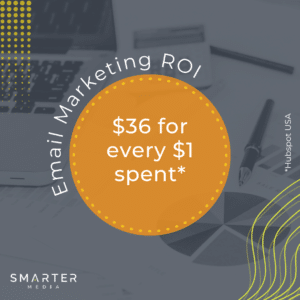
Due to the fact that Email Marketing is a form of direct marketing, this method allows senders to create content that is a lot more personal to their readers, meaning those receiving the email will not only feel special but also valued by your brand. Whereas because social media is a form of mass media, its content can be very generalised, due to the number of people it is trying to target.
People who sign up for an email newsletter do so because they are interested in your business and want to stay up to date with the latest news. This means that content being produced in an email campaign is very likely to be effective.
For example, if a popular clothing brand is having a sale and sent out an email to promote it, then it is likely that the reader will buy into the promotion as they like the brand and enjoy buying their products.
Email Marketing allows you to directly tell your customers about the latest offers, news, events and company updates. This helps keep customers engaged with the brand, which in the long run helps support the development of brand loyalty.
Email Marketing can also be used to communicate with customers who haven’t made a purchase in a while. A lot of successful brands do so by offering their customers a free gift or discount to encourage them to make a purchase and reengage with the brand. This is also a good way to remind customers of your brand's presence.
Email Marketing is a great way to increase brand recognition and secure more sales. For example, whenever a business runs a promotion, or has a new release, email marketing provides you with a quick and easy way to directly send this information to your customers, as well as links that allow them to make a purchase. You can also send follow-up emails to those who have made purchases from your store, as well as target potential customers.
Email Marketing platforms will provide you with useful insights into how effective each campaign was through open rate and click rate. This allows your business to see what is and isn’t working when communicating with your customers.
For example, certain times of day may be better than others to send out content or you may find you receive a higher level of engagement from customers on a weekday, as appose to a weekend.
So if you’re thinking about neglecting email marketing from your digital marketing strategy – think again!
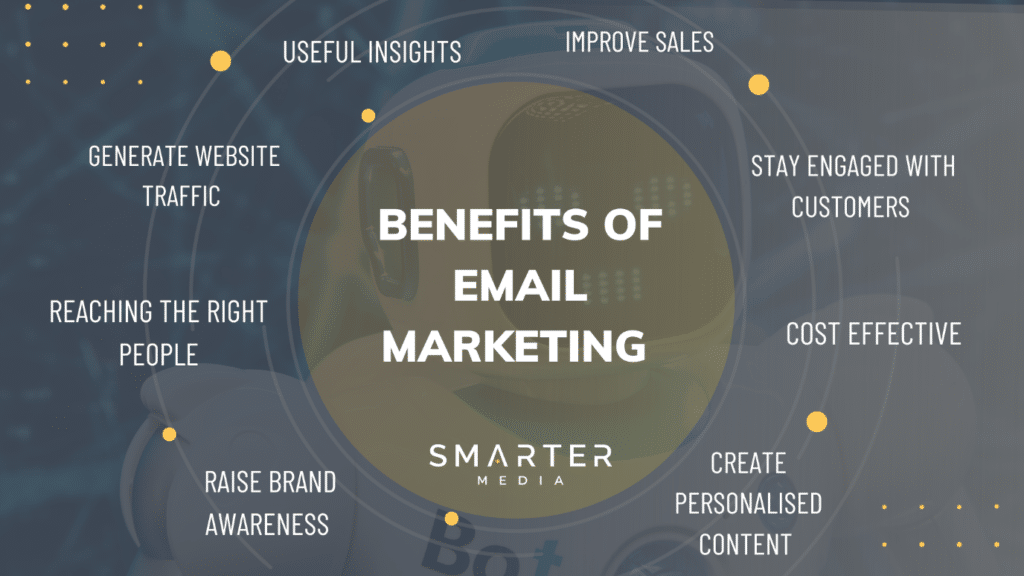
Don't miss out on the opportunity to leverage the power of email marketing for your business growth. Contact us today and let our expert team create customized email campaigns that drive results and boost your ROI. Take action now and unlock the full potential of email marketing for your brand.
Sustainable business practices are not only a moral imperative but also a key driver of long-term success - companies are seeking effective strategies to achieve both environmental impact and business growth. One such strategy that has proven to be highly impactful is content marketing.
By leveraging the power of compelling and informative content, businesses can engage with their target audience, build brand awareness, and foster meaningful connections. In this article, we will explore how content marketing can serve as a catalyst for sustainable business growth.
‘Content’ really is the foundation of all of your marketing activities, which makes it an extremely important element of your success! When viewed in isolation, content marketing can elevate your brand to ‘thought leader’ status, educate, inform and convert your target audience and differentiate your brand from its competitors.
When you consider the impact ‘content’ has on other marketing activities, however, you really begin to see its value. The quality and consistency of your content has a major impact on your search engine rankings, for example, which is why content marketing should be used in conjunction with search engine optimisation (SEO).
Similarly, the content you create and share on social media underpins your social media marketing (SMM) strategy, while ad copy and/or visuals have a significant impact on the success of your paid media campaigns.
As you can see, content marketing is integral to the success of your marketing activities, and it can (and should!) be a critical component of your green marketing strategy.
Green marketing refers to the practice of promoting eco-friendly brands, products, services or initiatives. If being environmentally friendly is a core component of your organisation, for example, you may want to work with a green or sustainable marketing agency to reach, educate and engage your target audience(s).
Similarly, if you’re modifying your operations to minimise your environmental impact or reduce your carbon footprint, a sustainable marketing agency can help you to integrate this into your brand’s ethos and raise awareness of your green objectives and activities.
Content marketing is a valuable way of increasing brand awareness, converting customers and fostering trust, but there are many ways it can help sustainable businesses to grow, such as:
To recognise the value of green businesses, products and services, your target audience must first understand the problem. Although consumer awareness of the climate crisis and environmental harm is increasing, don’t assume that your entire target audience will be aware of the issues you’re aiming to solve.
Instead, work with a green content marketing agency UK to educate the audience about the issue – and position your brand as the solution. This gives you the opportunity to put your sustainable operations into context and really explain why and how you’re making a difference and how your focus on sustainability sets you apart from your competitors.
Content marketing is a fantastic way to raise brand awareness. From thought leadership pieces and blog posts on your website to social media posts and press releases, there are many different types of content that can be used to share your sustainable messaging.
As environmental issues are continually growing in relevance and popularity, they are highly shareable online. This means that sustainability-focused content has an extended reach and the opportunity for reports, shares and likes is significantly increased. For companies that want to maximise their reach and boost awareness, marketing sustainability principles and activities is one route to success.
Fostering meaningful connections is vital if you want to retain your customers and build a following of loyal brand ambassadors. Fortunately, sustainable businesses can rely on their green credentials to establish trust and loyalty amongst their target audience.
By educating your target audience, explaining your sustainability strategy and keeping your customer base up to date with your sustainable initiatives, you can consistently build trust and gain their loyalty. With a regular cadence of sustainability-focused content, a green content marketing consultant can help you to deliver consistent yet innovative and exciting messaging that helps nurture long-term relationships with your target audience(s).
In most markets, consumers and B2B buyers are overwhelmed with choice and there’s no doubt your business will be facing competition from other companies. Developing your organisation into a sustainable business helps to set your enterprise apart from its competitors and gives your target audience a compelling reason to engage with your brand over any others.
However, you’ll need to convey your sustainable messaging in order to successfully differentiate your brand and how do you do this? Content marketing, of course! From blog posts and White Papers to videos, images and social media posts, there are endless formats that can help you to share your sustainable achievements and give you a competitive advantage.
Your conversion rate is arguably one of the most important metrics for your business. After all, generating a high volume of website traffic or getting large numbers of content views is beneficial, but it doesn’t equate to sales or profit. Instead, you need to ensure that your conversion rate is high enough to facilitate business growth and content marketing can help here too.
When a user sees any of your content, it should propel them through the sales funnel and strengthen the relationship they have with your brand. With help from a professional content strategist, you can ensure that your company’s content is designed to accelerate the customer journey while increasing conversions and optimising your commercial performance.
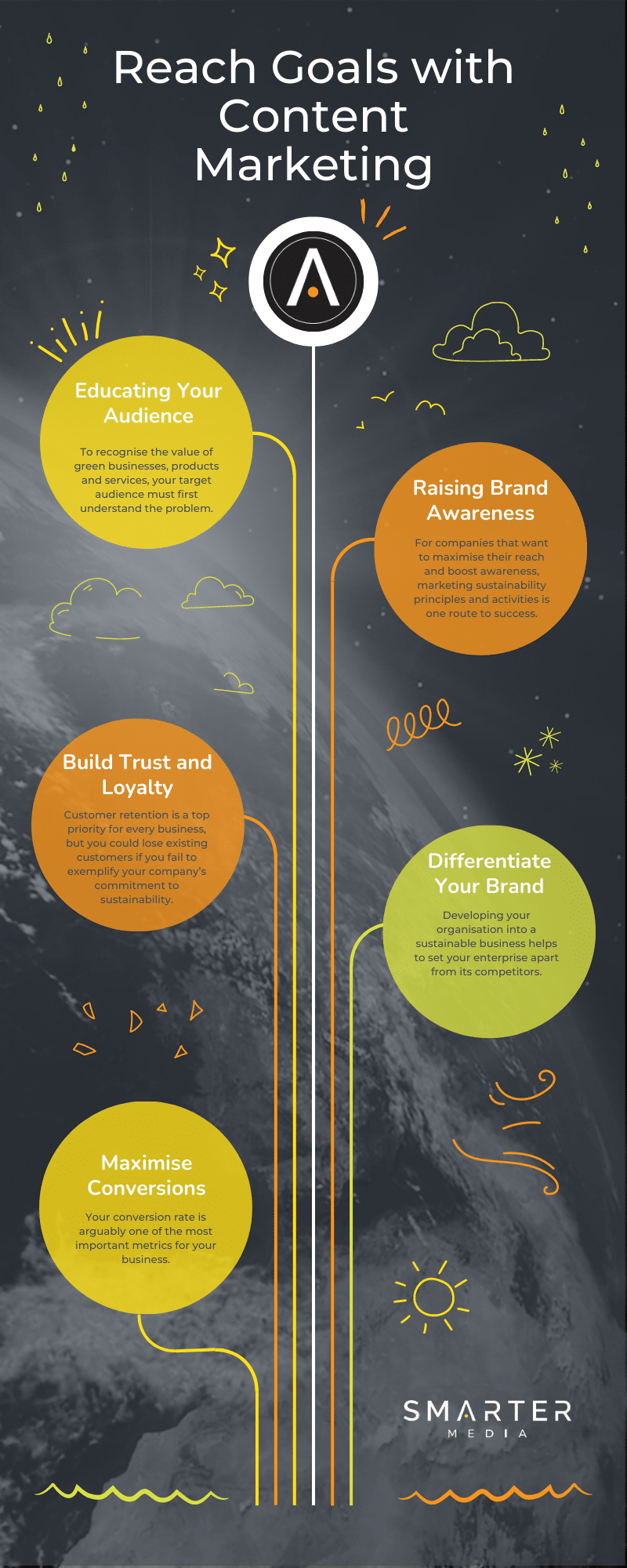
To succeed with content marketing, you need a detailed strategy that incorporates the frequency, format and theme of your upcoming content. Similarly, you’ll need a good understanding of your target audience(s) so that you can deliver content that’s relevant, engaging and compelling.
From audience research and content calendars to digital PR, content creation and reporting and analysis, our expert team provides innovative content marketing services that help sustainable businesses grow. To find out more, get in touch with the Smarter Media team today!
When looking into Digital Marketing, you may have come across the term ‘Email Marketing’. Since its birth, email marketing has become a powerful tool within an organisation's digital marketing strategy, hence why it still proves to be a vastly popular choice for digital marketers.
To help you understand the concept of email marketing further we will take a closer look at what email marketing is and where it is used.
In 1971, Ray Tomlinson sent the world’s very first email. Not long after in 1978, Gary Thurek, who at the time was working as a Marketing Manager for Digital Equipment Corp used email to directly communicate with his company's customers about a new product. This was the very first commercial email from a corporate company and is said to have resulted in $13 million worth of sales. It is this level of success which gave birth to what we now know as Email Marketing.
Email marketing is a digital marketing strategy that involves sending commercial messages to a group of people via email. It aims to promote products or services, build customer relationships, and drive engagement and conversions. By leveraging personalised content and targeted campaigns, email marketing helps businesses reach their audience directly and nurture leads.
When we talk about Email Marketing we are referring to a form of direct marketing, as well as digital, whereby businesses promote their products or services via email.
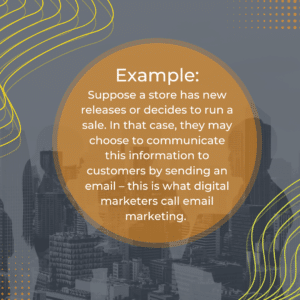
Sometimes, businesses may take on a softer approach, whereby they use email marketing to educate their audience on the true value of their brand to help keep them engaged between purchases. An example of this may be sending an email to customers about charity work the company's employees have been involved with or a climate pledge they have recently made to show how they are doing their bit to help the planet.
Email Marketing can also play an important role in customer lead generation, brand awareness and building strong relationships. This is why many successful brands implement email marketing into their digital marketing strategy, including Ted Baker, ASOS, Boots, Tesco, Pizza Express, Travelzoo and many more.
To help give you some idea of where email marketing is typically used, we’ve gathered up a few examples from popular brands to showcase how email marketing is used as a tool within a company's digital marketing strategy:

The frozen yoghurt company Pinkberry used email marketing to help reengage with customers who held a Pinkcard, but hadn’t ordered from them in a while. They did so by offering them a gift to encourage them to make a purchase.
This method not only got their customers to go onto their account and order additional products to go alongside their gift, but it also helped remind them about the brand’s presence and the tasty products they have on offer.

This campaign helped Starbucks showcase some of the benefits of holding a Starbucks membership. The image was used as a moving graphic which presented the reader with a number of different drinks they could get for a discounted rate if they held a Starbucks membership.
Since this email wasn’t just a static image, it helped make the campaign fun, while stressing the importance of exclusively for Starbucks members.

One of the great things about email marketing is the ability of personalisation – something which Spotify did very well with this email campaign. The subject line was “Olivia Rodrigo made you something special” which only went out to fans of the artist.
This meant that readers were very likely to click the ‘Buy Cassette’ call to action button as the email was not only relevant to their interests but helped make them feel valued by the artist.
At our digital marketing agency, we take a strategic and results-driven approach to email marketing, focusing on business growth and maximising return on investment (ROI) for brands and companies. Firstly, we conduct thorough audience research and segmentation to ensure that each email campaign reaches the right people with tailored messaging.
Secondly, we craft compelling and engaging content that not only promotes products or services but also adds value and solves customer pain points. Additionally, we optimise email deliverability and open rates through effective subject lines, personalised sender names, and proper list management practices.
Furthermore, we employ sophisticated email automation techniques, such as drip campaigns and triggered emails, to nurture leads and guide customers through the buyer's journey. Lastly, we track and analyse key metrics, such as click-through rates, conversion rates, and revenue generated, to continuously refine our strategies and achieve measurable business growth and ROI for our clients.
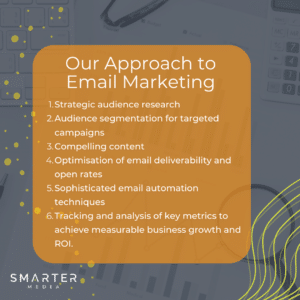
Don't miss out on the powerful potential of email marketing to boost your business growth and ROI. Contact us today and let our digital marketing agency unleash the true potential of your brand through effective and impactful email marketing strategies.
In today's rapidly evolving world, where environmental concerns have taken centre stage, businesses are increasingly adopting sustainable practices to meet the growing demand for eco-friendly solutions. At the forefront of this movement is the concept of green marketing. But what exactly is green marketing? How does it differ from traditional marketing approaches, and why is it crucial for businesses to embrace it?
In this comprehensive guide, we will delve into the world of green marketing, exploring its principles, strategies, and the transformative impact it can have on both brands and the planet. Join us as we uncover the power of sustainable branding and the role it plays in shaping a greener, more conscientious future.
Green marketing, also known as sustainable marketing, refers to the practice of promoting products or services that are environmentally friendly or have a positive impact on the planet. It involves incorporating eco-friendly attributes into marketing strategies, such as highlighting energy efficiency, sustainable sourcing, or reduced carbon footprint. Green marketing aims to appeal to environmentally conscious consumers and contribute to the overall sustainability goals of businesses and society.
Green or sustainable marketing refers to the promotion of eco-friendly products, services, initiatives or brands.
In some instances, green marketing can be used to raise awareness of new companies that have been developed with the specific aim of enhancing the environment and protecting the planet. Alternatively, existing companies may use a sustainability marketing agency to promote their green initiatives and educate their customer base about their sustainability strategy.
If you’re still wondering, what is sustainable marketing, then taking a look at some examples will certainly make things clearer.
A ClimateTech company that develops a new product to reduce CO2 emissions in the logistics industry may use green marketing to ensure the market is aware of their new innovation, for example.
Alternatively, an established and well-known global cleaning products company may rely on sustainable marketing to show that they are committed to reducing their carbon footprint and making their products more environmentally friendly.
As companies transition from using single-use plastic packaging, for example, they often use green marketing to make their target audience aware of their increased sustainability.
Marketing is essential for every business, but what’s so special about green marketing, and why is it so important?
As awareness of the climate crisis grows, environmental concerns are becoming increasingly important in the decision-making process of consumers and B2B buyers. Many consumers are actively seeking out brands, products and services that enhance the environment, rather than harm it. As a result, companies need to adjust their operations to maximise sustainability and, crucially, make people aware of their commitment to sustainability.
Green marketing is the ideal way to achieve this goal. By educating your target audiences about your sustainable practices and ethos, you can attract new customers and even increase retention rates too.
While many companies are choosing to build a more sustainable future, there are an increasing number of regulations that demand businesses operate in a more environmentally friendly way. The incoming Corporate Reporting Sustainability Directive (CSRD) will mean that many organisations are required to report emissions across their entire value chain, for example.
This is particularly important for B2B companies, who will want to partner with businesses that have established emissions monitoring and transparent sustainable practices. So, businesses operating within the B2B sector may work with a B2B content marketing agency to ensure their target audience is aware of their sustainable operations.
Meeting stakeholder expectations is vital for continued success, particularly if businesses are reliant on shareholders to generate funds. In today’s environmentally aware landscape, investors are placing more reliance and emphasis on environmental, social and corporate governance (ESG), which naturally includes a company’s carbon footprint and sustainable practices.
If companies want to educate and satisfy their stakeholders about their ESG strategies, green marketing is the obvious way to do so. With a focus on the brand’s environmental and sustainable performance, green marketing can enhance the perception of the brand and reassure stakeholders that the company is transitioning to a more sustainable future.
Similarly, ESG factors are increasingly important to companies who are seeking investments. In fact, potential investors or venture capital firms will use established ESG assessments to determine the suitability and potential of an investment opportunity.
For any company that wants to create a viable growth strategy, it’s important, therefore, to factor ESG, sustainability and green marketing into its future. By using green marketing to showcase and exemplify the brand’s sustainable operations, for example, companies can secure additional investments both now and in the future.
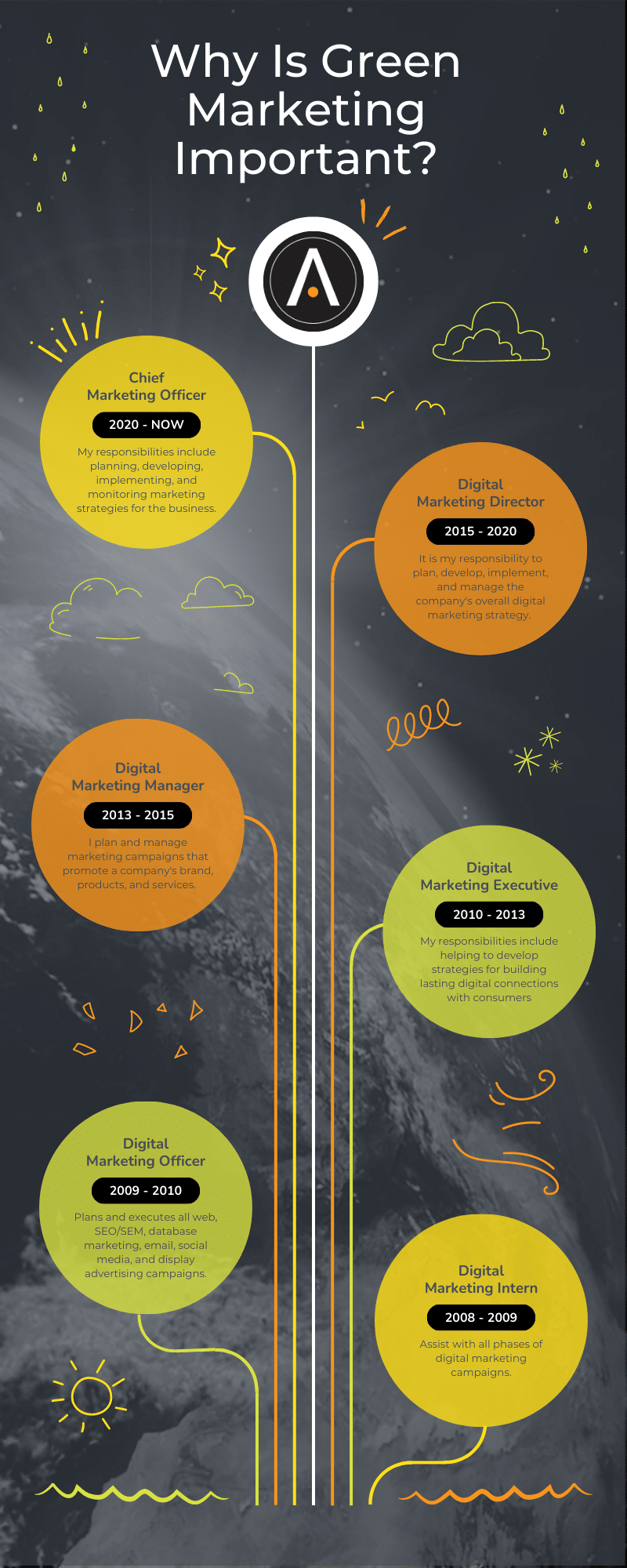
Green marketing works in a similar way to regular marketing, but it places an emphasis on the company’s environmental and sustainable performance or the environmental impact of its products or services.
A successful green marketing strategy incorporates a variety of goals and KPIs and uses a range of activities to achieve these objectives. For example, a company may want to increase awareness of its new sustainable packaging. To facilitate this, they may work with a content marketing agency and use green content marketing services to explain how their new initiative will decrease the brand’s environmental impact.
Then, the firm may use various marketing activities, such as search engine optimisation (SEO) and paid media, to reach and engage its target audience(s).
As you can see, the underlying principles of green or sustainable marketing are the same as regular digital marketing. By recognising the importance of a brand’s environmental impact, however, we can use green marketing to help the company achieve its overarching objectives, such as:
People often assume that green marketing is only suited to companies that are wholly focused on the environment, but this simply isn’t the case. Environmental awareness and climate concern is now mainstream, which means companies across all sectors and industries must recognise the effects that sustainability (or lack of) can have on their commercial success.
By integrating green marketing into your current marketing strategy, you can expand your messaging, engage your target audiences and futureproof your brand. To find out how green marketing can enhance your strategy, contact us at Smarter Media today!
